Sugar gliders come in a large variety of different colors and patterns. Because of this, making a choice of which type of glider you want can sometimes be a problem.
To help remedy that problem, today we’re going to take a closer look at the 18 different sugar glider colors and patterns. That way, you have a better idea of all the different varieties these cute marsupials can have.
Before we go over all the sugar glider patterns and colors, let’s briefly discuss breeds. Many people believe that there are distinct sugar glider breeds, but that’s not the case. There’s only 1 sugar glider breed that people keep as pets, the Petaurus breviceps. All the variations are just different colorations, patterns, and traits, but not different breeds.
With that being said, let’s take a closer look at all the 18 colors and patterns that sugar gliders can have, shall we?
Leucistic Sugar Glider
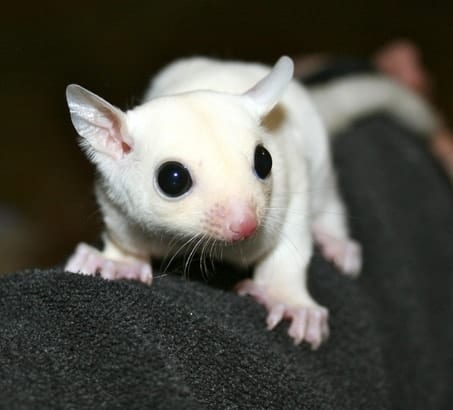
The Leucistic sugar glider, also known as the white sugar glider, has a completely white color, except for its eyes, which are a deep black. They are white because of a loss of pigmentation in their hair, but not their eyes. Their paws and nose are a bright pink color and they do not have any markings or stripes on their body.
Melanistic Sugar Glider
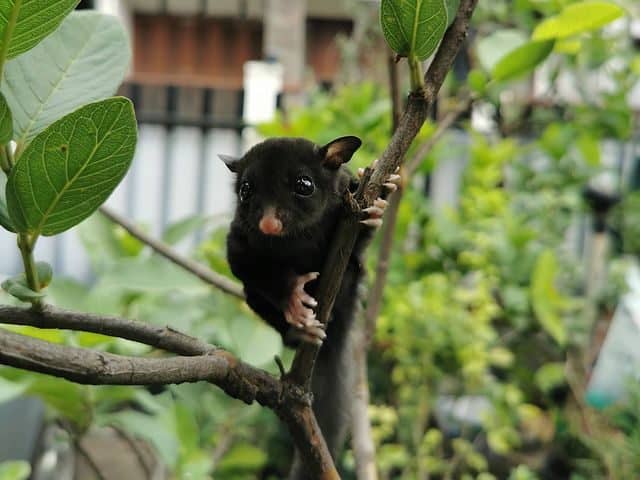
The melanistic glider is the opposite of the leucistic glider. Whereas the leucistic glider has a lack of pigment, the melanistic glider has a lot of it, resulting in very dark fur.
The dark fur of these suggies makes them very desirable, but they’re also quite rare. If you want to buy a black sugar glider, this is your best bet.
Albino Sugar Glider
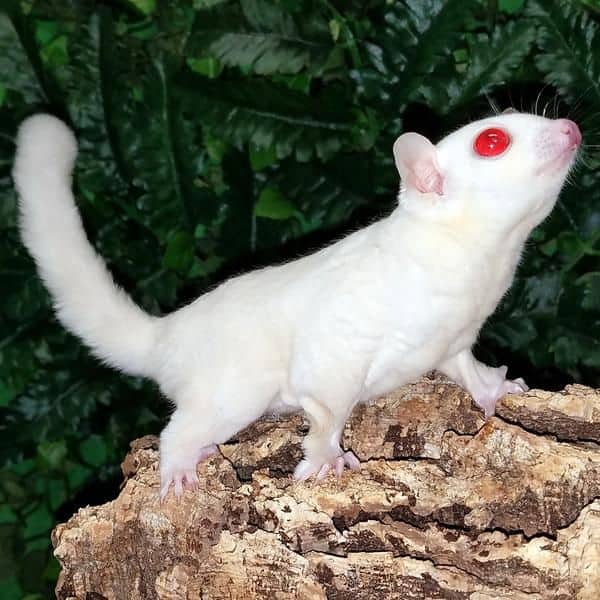
The Albino sugar glider is characterized by its all-white fur and red eyes. Many people confuse the Albino Sugar glider with the leucistic sugar glider. The difference is in the eyes. Leucistic sugar gliders have black eyes while those of albino gliders are red.
Albinism in sugar gliders is caused by a mutation in the melanocyte cells.
Caramel Sugar Glider
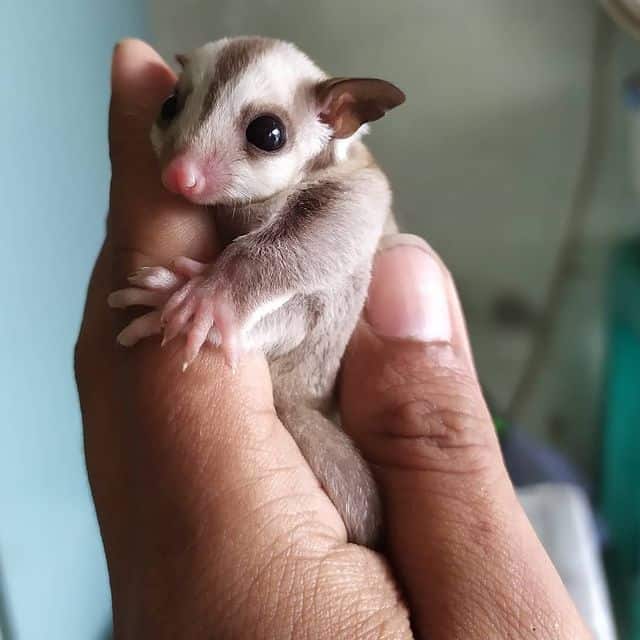
Caramel Sugar Gliders are often thought to be a different species. They’re really not, but it’s easy to see why people think so. For starters, they’re about 20% bigger than other gliders. They also have bigger ears.
Color-wise, the caramel glider is characterized by having a caramel-colored body with white hands and a cream face.
Ruby Leu Sugar Glider
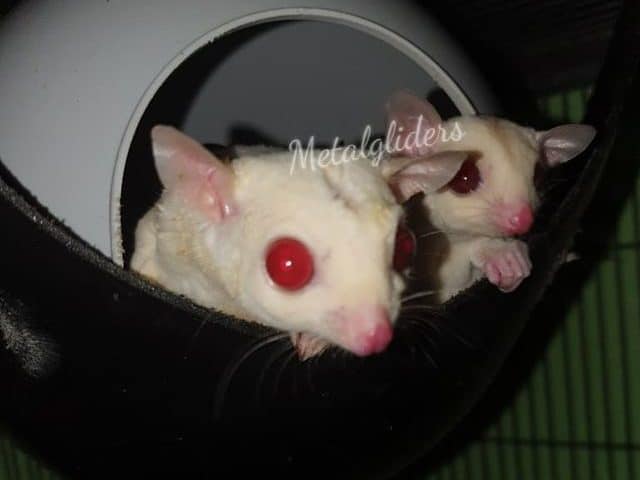
The Ruby Leu is a double recessive sugar glider. What this means is that they have a combination of two recessive genes which results in a white coat with red eyes, giving them a very similar appearance to albino gliders.
There are 5 recessive traits that can be bred to try to achieve this combination:
- Albino and Leucistic
- Creamino and Leucistic
- Albino and Platinum
- Creamino and Albino
- Creamino and Platinum
Standard Gray Sugar Glider
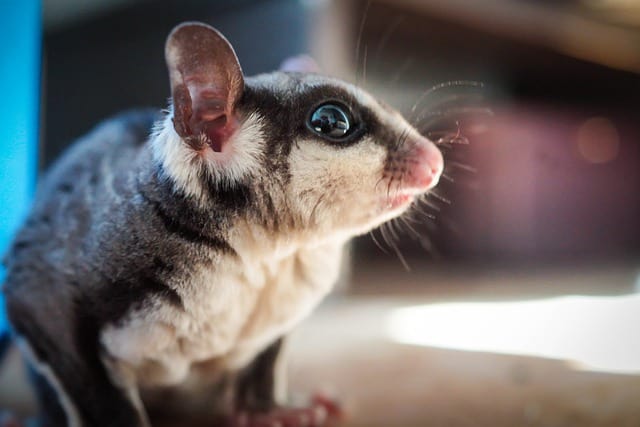
This is the most common color/pattern for a glider to have. Think of this as the default color of a sugar glider.
The gray coloration can have different shades, ranging from relatively pale to quite dark. They have a stripe running across their skull and spine that’s darker in color than the rest of their coat.
All the colorations that will follow below are variants of Standard Gray.
Black Beauty Sugar Glider
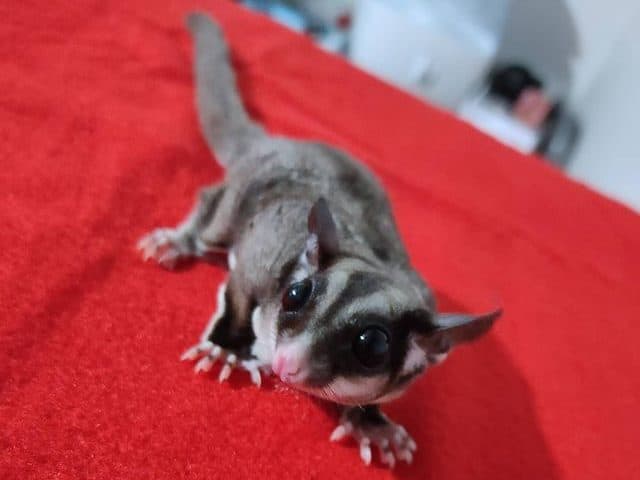
The black beauty coloration is a variation of classic gray. The differences between classic gray and Black Beauty are mainly in the intensity of the colors of the markings.
Black beauties have much bolder and darker markings, giving them an appearance that’s very distinctly different from that of classic grays.
They have markings around their eyes, on their knuckles, a chin strap, and an undertone on their fur.
The occurrence of the Black Beauty appearance seems to be random, although some breeders have managed to successfully breed for them.
Mahogany Red Sugar Glider
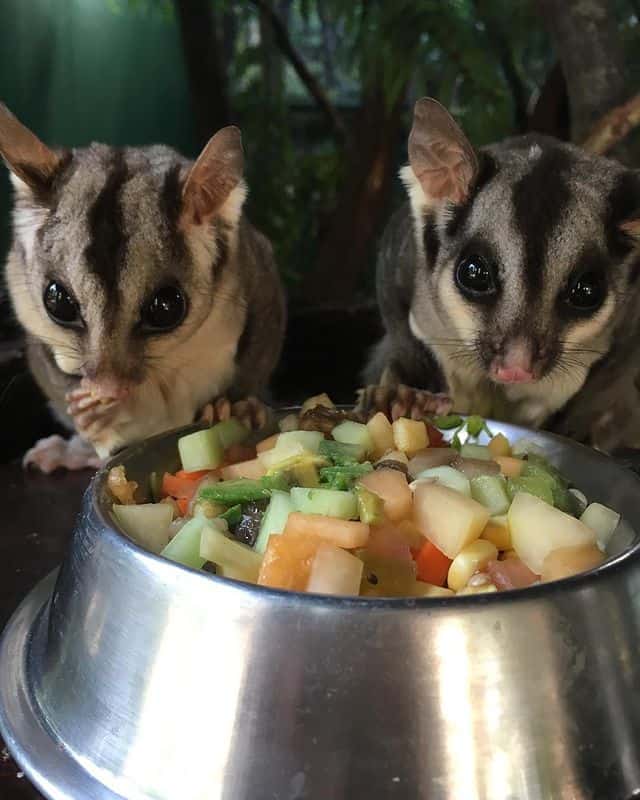
The Mahogany Red sugar glider is characterized by having a very lightly colored red throughout its coat. Their patterns and markings are quite similar to that of the standard gray, which they are a variation of.
The Mahogany Red Glider can also be white fac. The difference between a white face mahogany red glider and a standard one is that the white face has a mostly white face without any markings under their ears.
Quite recently, it was discovered that the Mahogany Red Glider can also be Albino.
Cedar Red Sugar Glider
The cedar red is very similar in appearance to the mahogany red glider. Both have red coloration throughout their coats. The difference is that the red coloration of the Cedar is much darker and deeper.
Lion Sugar Glider
The Lion glider is visually very similar to the standard gray glider. They’re a variation of the standard gray with a honey-colored hue in their fur.
These gliders are closest to what could be considered a different breed: they typically have a shorter nose and a more rounded face than other colorations.
The Lion Sugar Glider also has a white face variety.
White Tip Sugar Glider
The white tip sugar glider is yet another variation of the standard gray. Their appearance is almost identical to that of the standard gray except for the white tip at the end of its tail.
The gene responsible for this interesting phenomenon is recessive, meaning that to breed white tip sugar gliders you have to breed two of them together.
Cinnamon Sugar Glider
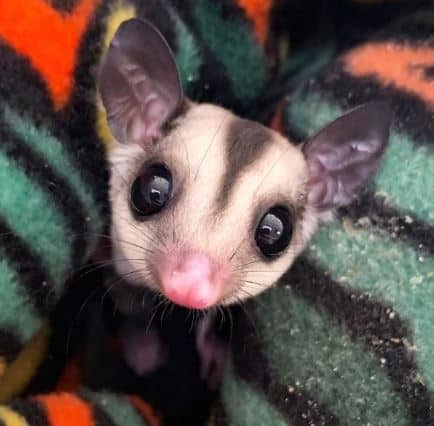
The Cinnamon Glider has a brown, cinnamon-like color with a dark brown stripe running from the top of their head along their spine towards their tail.
White Face Sugar Sugar Glider
The white face glider is characterized by the lack of markings under the ear towards the chin, something other gliders do have. An interesting thing about the white face gene is that it’s dominant, meaning that it can be bred to any glider. This is also the reason that so many other colorations have a white face variant. White face is not a color, but rather a trait.
The colors below are colorations that exhibit the white face trait.
White Face Blonde Sugar Glider
The white face blonde glider is almost identical to the White Face except the fur is a slightly lighter color.
Platinum Sugar Glider
The Platinum sugar glider has a silver/gray body with a gray-colored stripe along its back and head. This stripe is typically narrower in platinum gliders than in other colorations.
The gene that’s responsible for creating platinum gliders is recessive, meaning that you must breed two platinum gliders together to be able to create more of them.
Creamino Sugar Glider
As the name suggests, the creamino sugar glider has a cream-colored body. They have tawny/tan markings in the form of a stripe on their body and garnet eyes.
The gene responsible for creating Creamino gliders is recessive. Because of this, you have to breed two Creamino gliders together in order to create more of them.
Mosaic Sugar Glider
Mosaic is not actually a color, but rather a name for the mosaic-like pattern that can appear on many gliders. These patterns are unique for every glider, making no two mosaic gliders identical!
What all Mosaic sugar gliders do have in common is that they all have white hands (it can even be just 1 finger) and white/black whiskers. If they do not exhibit these characteristics, they did not inherit the mosaic gene from their parents.
All the gliders that will follow below are variants of the Mosaic Sugar Glider.
Piebald Sugar Glider
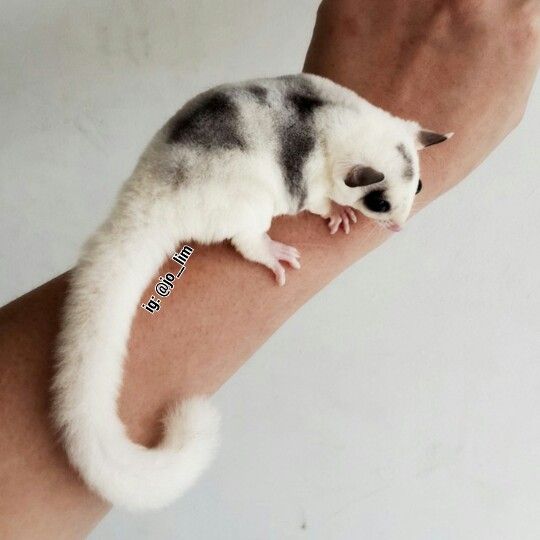
The piebald sugar glider can be recognized by the white hair on its back in combination with dark patches of hair. The black and white coloration appears randomly and is often not symmetrical.
Silver Mosaic Sugar Glider
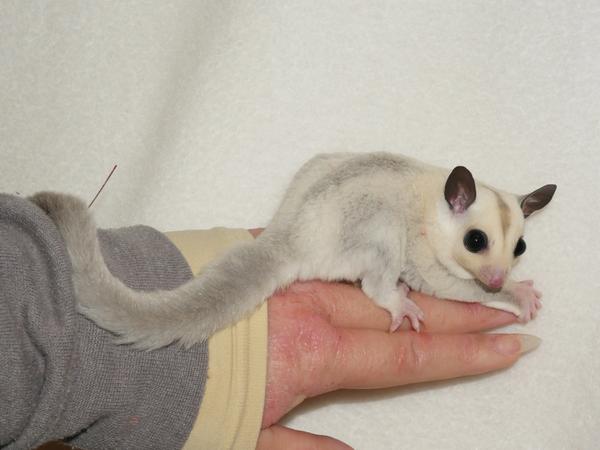
The Silver Mosaic Glider is often confused with the platinum sugar glider. They are very similar in appearance but are not the same because the silver glider lacks platinum genetics.
They’re recognized by their silver-like hair color.
Ringtail Mosaic Sugar Glider
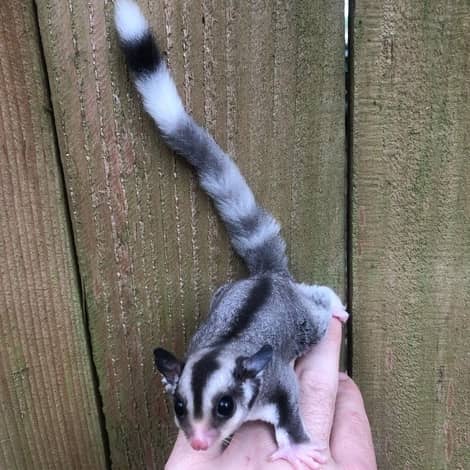
The Ringtail Mosaic Glider has a very distinct pattern of rings on its tail, making them very easy to recognize. These rings are black and white in color. The amount of rings that are present is random and varies from glider to glider.
True Platinum Mosaic Sugar Glider
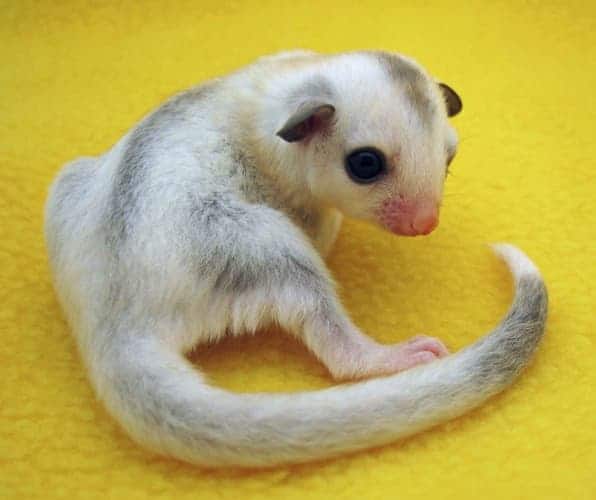
The True Platinum glider is a platinum and mosaic glider at the same time. Meaning that it exhibits the traits of any of the mosaic glider colorations but is at the same time genetically a platinum glider.
White Mosaic Glider
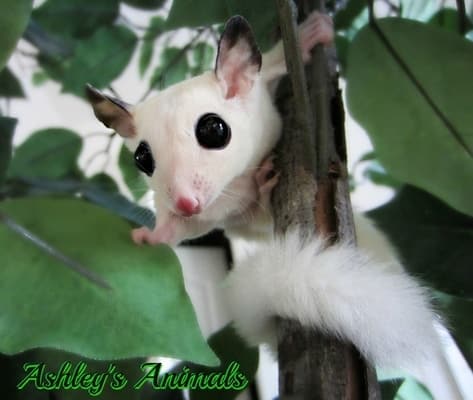
The White Mosaic Glider very closely resembles the leucistic sugar glider. It’s very easy to get them confused, and many people do so. The trick is to look at the ears. White Mosaics will have pigmented ears, giving them a dark color, while the ears of the leucistic glider are pink
Final words
With this crash course in sugar glider colors, patterns, and traits you’ve become a true expert on everything there’s to know about all the different colorations these beautiful animals can have.
I hope it cleared everything up and that it helped you make a decision on which color you like most. I know it’s a hard decision, they’re all just so dang cute. To learn more about these magnificent animals, check out these sugar glider facts!
- How Long Do American Eskimo Dogs Live? Important Factors and Care Tips - September 29, 2023
- Do American Bulldogs Need Grooming? Essential Tips and Care Guidelines - September 29, 2023
- Do Bengal Cats Enjoy Playing? Essential Tips for Keeping Them Active - September 29, 2023